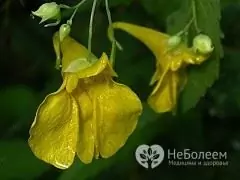- Author Rachel Wainwright [email protected].
- Public 2023-12-15 07:39.
- Last modified 2025-11-02 20:14.
Forest balsam
Instructions for use:
- 1. Chemical composition
- 2. Useful properties
- 3. Indications for use
- 4. Contraindications
- 5. Home remedies

As a medicinal plant, balsam is widely known in the Urals and Siberia under the name "Vanka wet", in Central Asia and the Caucasus it is called "touchy". The plant received all these names because of its characteristics. Firstly, ripe fruits of balsam crack, scattering seeds on the sides, at the slightest touch to them, hence the name "touchy". Secondly, along the edges of the leaves of the plant, droplets of whitish liquid appear, for which he was nicknamed "Vanka wet".
There are several varieties and varieties of this plant. In Russia, it was grown as an indoor flower, and now balsam is very popular among gardeners. In total, about 400 ornamental plant species are known, but those that grow only in forest zones with a temperate climate - only 8. And it is forest balsam, although it is poisonous, belongs to the category of medicinal herbs and is used with caution for health purposes.
Chemical composition
The plant contains a large amount of ascorbic acid (exclusively during the flowering period). In addition, the stems and leaves contain alkaloids, acids, glycosides, flavonoids and tannins.
Beneficial features
Forest balm has a diuretic, antiseptic, laxative and decongestant effect.
Indications for use
Forest balsam is used in the presence of kidney and bladder stones, dropsy, external hemorrhoids, rheumatism, and also as a disinfectant.
Contraindications
The use of forest balsam has a number of contraindications. Preparations from this plant are strictly prohibited for pregnant and lactating women, children under 14 years old and people with diseases of the digestive system.
In case of an overdose, balsam causes poisoning.
Home remedies from forest balsam
Due to its healing properties, forest balsam is an excellent wound healing and anti-inflammatory agent for external use. For washing wounds, including purulent ones, as well as ulcers and hemorrhoidal cones, a decoction of the plant is used, which is prepared at the rate of one tablespoon per glass of boiling water. A gauze swab is moistened in it, which is then applied to the inflamed surface.
Freshly squeezed juice from balsam leaves is great for healing wounds and soothing pain, but should be used with great care.
Forest balsam is highly valued in folk medicine for its beneficial effect on the kidneys and the entire urinary system. The plant has proven itself to be excellent in the treatment of kidney and bladder stones. The substances contained in it grind stones into sand and smoothly remove them. In addition, the plant contains compounds that help remove excess fluid from the body.
Take the infusion and decoction of this herb should be strictly dosed, remembering that it is poisonous. In order to prepare the infusion, take one teaspoon of balsam leaves and stalks, pour a glass of boiling water and infuse for 20 minutes in a warm place. Take the infusion of the plant no more than one tablespoon at a time and no more than two tablespoons per day.
In addition to urolithiasis, balsam is used to treat gout and rheumatism: baths are made with the addition of a concentrated decoction, and one tablespoon of the herb infusion is taken orally after meals.
Information about the drug is generalized, provided for informational purposes only and does not replace the official instructions. Self-medication is hazardous to health!






